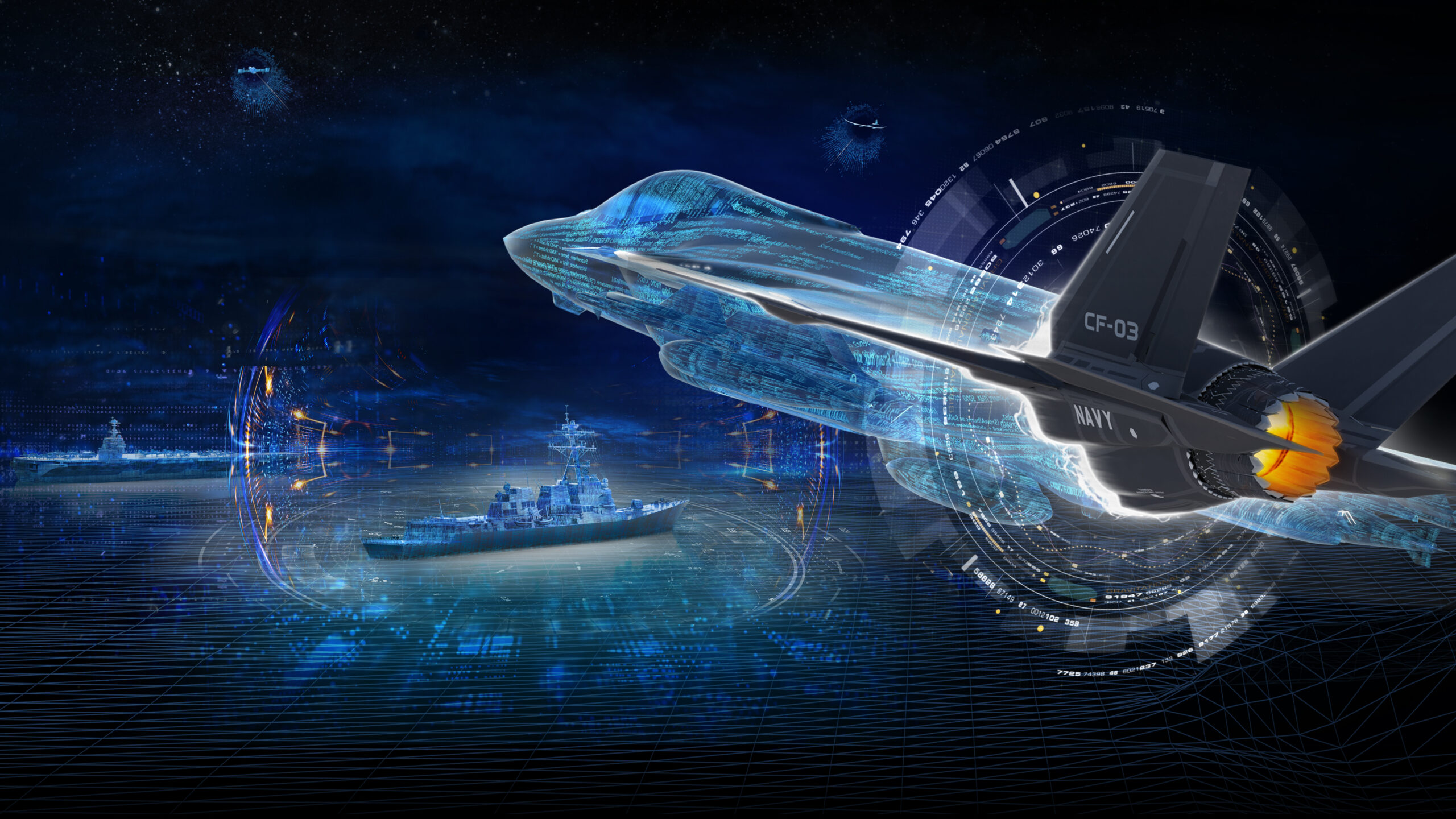
When moving move data between network nodes, the warfighter doesn’t care which pathway they use, whether it’s HF or MIDS JTRS or from ground to air. Illustration courtesy of BAE Systems.
In this Q&A with Jennica Dearborn, deputy vice president and general manager, C4ISR Systems at BAE Systems, we discuss the role of CNI in the times of the Great Power competition, collaborating with third-party companies on high-frequency [HF] radios, and what it means to have full-spectrum capabilities.
Breaking Defense: CNI is an acronym that’s been around for a long time. What’s the importance of CNI today in light of the Great Power competition? Is the acronym still relevant or should it evolve like SWaP evolving into SWaP-C?

Jennica Dearborn is deputy vice president and general manager for C4ISR Systems at BAE Systems.
Dearborn: The acronym’s relevancy as it relates to the intended capabilities certainly perseveres. Communications, navigation, identification all remain key mission enablers.
Communication – you need the ability to communicate in contested environments, with low probability of intercept and low probability of detect. They absolutely have to be resilient to disruption.
Navigation – you need to navigate successfully with and without GPS by understanding the world around you.
Identification – you need to determine who’s in your battlespace and be able to rapidly assess whether those entities are friend or foe.
To your point around the Great Power competition, all of those capabilities under the CNI umbrella are evolving to put real emphasis on increased speed of information, decision-making, and resilience to disruption.
Regarding the evolution of acronyms, there is an element of increased emphasis, though, not conveyed in any of those individual elements of CNI. That’s the overall networking and sense-making – using the information across the battlespace to make decisions at the speed of relevancy, with a focus on leveraging all the communications nodes within an interoperable, heterogeneous warfighter network.
And then synthesizing the data from all the sensors in the ecosystem using data analytics, artificial intelligence [AI] and machine learning [ML], particularly at the edge, so you can distribute the decision making and act more quickly.
In that respect, there is an evolution in the emphasis of CNI and what that foundation is building up to, and you need all those pillars to execute your mission.
Breaking Defense: What are the DoD’s needs for current and future fleets around flexibility, integration, and speed to maintain situational awareness and battlefield superiority?
Dearborn: I’ll summarize a couple of demand signals that we see from our customer base, and you touched on one of them, flexibility. How do you, with the appropriate amount of agility, integrate new capabilities into existing solutions without significant recapitalization or upgrade cycles whether you’re upgrading existing systems or building flexibility into future solutions? The emphasis on speed is not just around decision making, but also about getting capabilities into warfighter hands as quickly as possible.
Part of that is doing more with what you have, which means upgrading some existing federated solutions to add capacity and capabilities. We’re doing that with new software applications that use data being collected from communications and sensing nodes in a novel fashion to provide warfighters more advantage.
And then, as I touched on, architecting new solutions with scale and flexibility in mind. We’re designing products that can scale to various platform sizes, and doing so by embracing modular open system architectures [MOSA] and also partnering with others to deliver advanced solutions.
We are collaborating for success by tapping into the innovation ecosystems within our communities to discover new ways of working and leveraging key technology enablers. This also includes strengthening supplier relationships. One example of this is on the Air Force’s Airborne High Frequency Radio Modernization [AHFRM] program that provides a secure alternative to satellite communications. We’re collaborating with a commercial business named FlexRadio and we are taking their commercial off-the-shelf [COTS] product and tailoring it for military use.
Breaking Defense: You talk about developing, manufacturing, and delivering CNI products that provide next-gen edge and battlefield advantage against near-peer threats at the pace of technology, not the pace of acquisition. Explain.
Dearborn: I mentioned MOSA earlier and it’s about building that into your product offering. We’re in the business of software-defined radios and we’ve been able to demonstrate that for decades. Essentially, they’re customized by the software you load onto them, making them configurable and flexible to the evolving need.
One of the ways we are putting the approaches we discussed into practice is with our FireNet™ system, which is our latest software-defined radio enabling line-of-sight voice, data, and network communications in a small form factor scalable for the platform needs. We saw the need for added capabilities from various customers whether it be added channels, waveforms, SWaP-C and proactively initiated designs. The open-system architecture communication system maximizes flexibility with a small, standardized footprint, minimizing integration effort for a wide range of mode and waveform capabilities for existing aircraft and future fleets.
It’s both in how you design your software to be containerized and modular and how you design your hardware to non-proprietary open standards in a building-block fashion so you can size up or down based upon the need of the platform; you don’t have to repeat the design cycle every time. We’re fully embracing those approaches and their solutions going forward, and we’ve certainly got a history of doing that.
We’ve also embraced the improved interoperability over the lifecycle of our products that comes from the use of government-specified waveforms. This makes our software-defined radios adaptable as the ecosystem of communications products evolve.
It’s important as we look at the entirety of the warfighter network and interoperability between systems that we’re fully aligned with our government customer, with them in the driver’s seat of what that ecosystem looks like.
Breaking Defense: Let’s get into your CNI market history and contributions in IFF, tactical datalinks, and radios. What does it mean to have “full-spectrum” capabilities, and why should the warfighter care?
Dearborn: Looking back, we’re proud of the legacy of the products that we’ve been delivering to the warfighter that provide secure, resilient, reliable connectivity and actionable intelligence when they need it most. This business has been working at that for about seven decades, and delivered over 20,000 products shipped and installed in at least 56 allied nations.
We’re a leader in the identification friend or foe, or IFF, systems of transponders, interrogators, and combined interrogator transponders, depending on platform needs and requirements.
Another big piece is MIDS JTRS [Multifunctional Information Distribution System – Joint Tactical Radio System], the software-defined radios that run the complex TDL [Tactical Data Link] waveform plus up to three more communication protocols. That lets US forces and NATO countries exchange accurate, reliable, real-time voice and data in hostile environments.
To unpack that a bit more, because you referenced full spectrum, I view that from a number of different dimensions – from the customers we support, the people that do our critical work, and the multi-band communication products we provide that cover several points on the electromagnetic spectrum from HF to Ku and beyond, including programs like NTCDL, the Network Tactical Common Data Link.
In 2022, we announced that we are entering the production phase for seven NTCDL systems for the US Navy that let them simultaneously transmit and receive real-time ISR data from multiple sources, while enabling the exchange of command and control information over multiple datalinks. The systems will be installed on aircraft carriers and the new Constellation-class frigates.
To your question around why it matters. In the context of JADC2, when we talk about the warfighter network and the sense/make sense/act strategy, network convergence is important. When you want to move data and information quickly and reliably between all of those nodes, the warfighter user doesn’t care which pathway you use, whether it’s HF or MIDS JTRS or from ground to air. They just care that the data gets reliably between point A and B, and our full-spectrum coverage in all of our communications devices gives us unique visibility into all the pathways on the network to help implement and solve that JADC2 sense/make sense/act strategy. That to me is why it matters.
Breaking Defense: People and culture are key enablers to delivering on BAE Systems’ programs. How so?
Dearborn: We’re a world leader in aerospace and defense, and we make everything from aircraft carriers and fighter jets to electronic systems like what we’re talking about today. Within the BAE Systems Electronic Systems sector’s C4ISR Systems business area, which I support, our portfolio spans all elements of the TCPED [tasking, collection, processing, exploitation, dissemination] loop and JADC2 strategy, to include space sensing, data analytics, AI/ML, covering all elements and nodes of that TCPED loop.
We’re big enough to play a meaningful role across all of those different nodes, but nimble enough that we can mobilize and engage our teams and our customers to deliver on the missions that are being talked about today.
The second point I would make is around our culture, around embracing and fostering diversity, equity, inclusion [DE&I], which I see as a unique discriminator for us.
DE&I and all voices is not just the tagline, it’s embedded in our DNA and that shows in the hard problems that we’re solving for today and tomorrow. We collaborate well amongst ourselves, industry partners, and customers to deliver on our mission. We act on our mission every day: We Protect Those Who Protect Us®.
Breaking Defense: Final thoughts?
Dearborn: CNI is certainly an acronym that encompasses a lot of capabilities, and we offer a full spectrum set of solutions to give our warfighters secure, resilient, reliable connectivity, actionable intelligence, and we very much are proud of our ongoing contributions doing that.
We’re just as excited about continuing to innovate for future solutions to address the near-peer threats. We understand the customer’s needs for future fleet flexibility, interoperability, and certainly speed so that they can maintain situational awareness and battlefield superiority.
We’re continuing to deliver on that by embracing open system architectures, and integrating at the pace of technology, not just the pace of acquisition. We understand that flexibility, speed, cost, and interoperability are important across all product life cycles. It’s not just about sustaining a good product for a number of years, it’s keeping it relevant through rapid upgrades.





















